Continuing our series of How Not to Get Fooled by Statistics our post today is about recognising misleading graphs or charts. Data visualisation is good, it helps us easily understand otherwise complex data and focus on what’s important. However, it is also a powerful tool for data manipulation and deception. There are so many misleading graphs and charts out there, it’s terrifying!
Scales distortion
One of the ways to use charts to manipulate data is to distort scales. Have a look at this Chevy ad from 1992:

Image source: https://ed.ted.com/lessons/how-to-spot-a-misleading-graph-lea-gaslowitz
“More than 98% of all Chevy trucks sold in the last 10 years are still on the road”. Looks impressive, right? Now, let us have a closer look at it. When we see this kind of graph, we automatically think that sizes of the bars are proportionate to their values. So, visually Chevy’s bar looks almost twice as big as Toyota’s. But if you look carefully you will notice that the Y axis starts from 95%, so the percentage for Toyota is actually a bit higher than 96%.
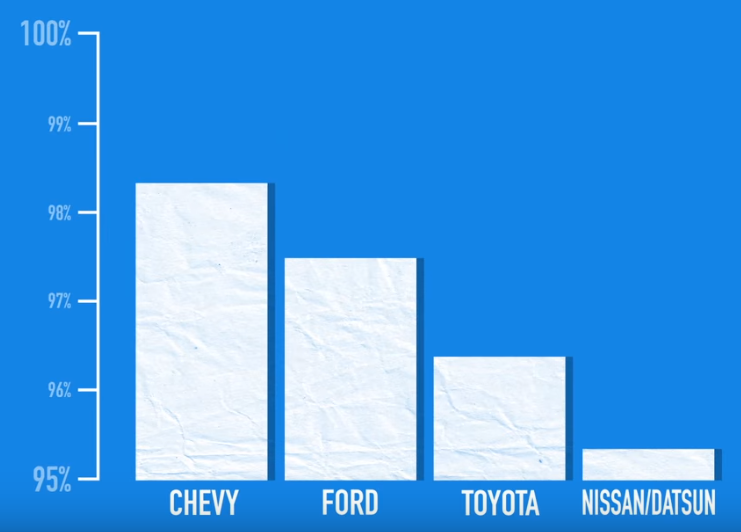
Image source: https://ed.ted.com/lessons/how-to-spot-a-misleading-graph-lea-gaslowitz
If we were to reset the Y axis to start from 0, then the graph would look more like this:
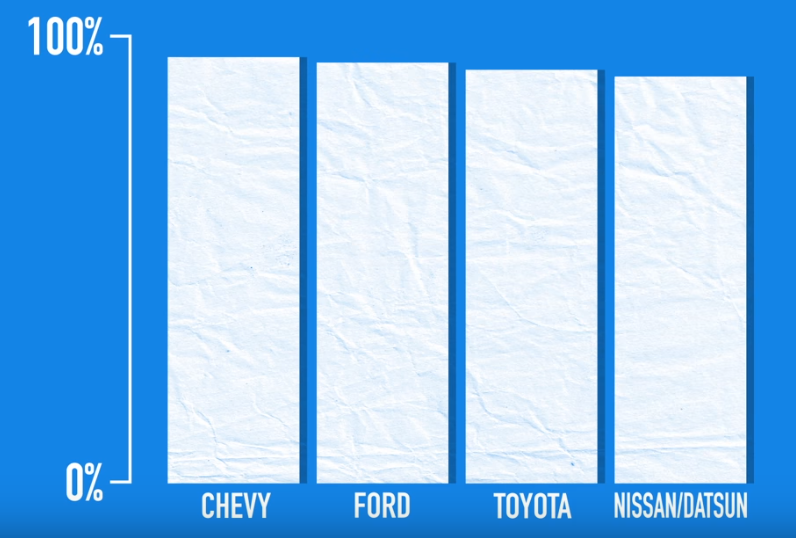
Image source: https://ed.ted.com/lessons/how-to-spot-a-misleading-graph-lea-gaslowitz
Now the visual difference is not that big which makes the claim much less impactful.
3D pie charts
I personally think using any 3D charts should be made illegal to begin with. I don’t know why anybody would want to use them… Oh wait a minute, I do know! They want to use them to exaggerate certain data points and make others look much less visible.
Look at this chart from the Hyundai Verna ad below. The slice for Verna is at the foreground and of a bright yellow colour while all other brands are on the background and have a dark colour. This way all your attention is focussed on the big Verna slice.

Image source: https://chandoo.org/wp/why-3d-pie-charts-are-evil/
Now, let us see what happens if we make this chart flat:
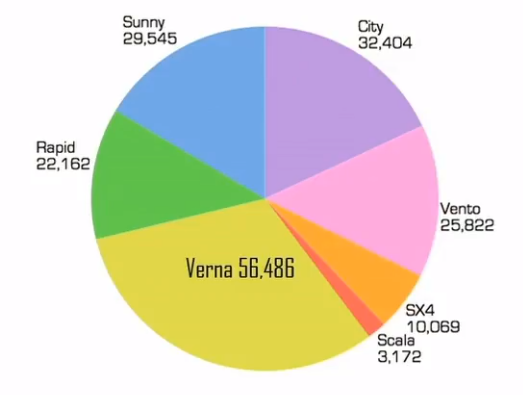
This way Verna still has the biggest share of the pie, but you can also clearly see all other brands and their values. Now Verna doesn’t look as dominant as in the previous version of the chart.
Using the wrong types of charts for the purpose
There is a wide variety of different types of charts which is great, but each of them is good for its purpose. Imagine your data looks like this:
| Brand awareness | |
| Brand A | 70% |
| Brand B | 60% |
| Brand C | 65% |
Now, let us build a pie chart using the data from this table:
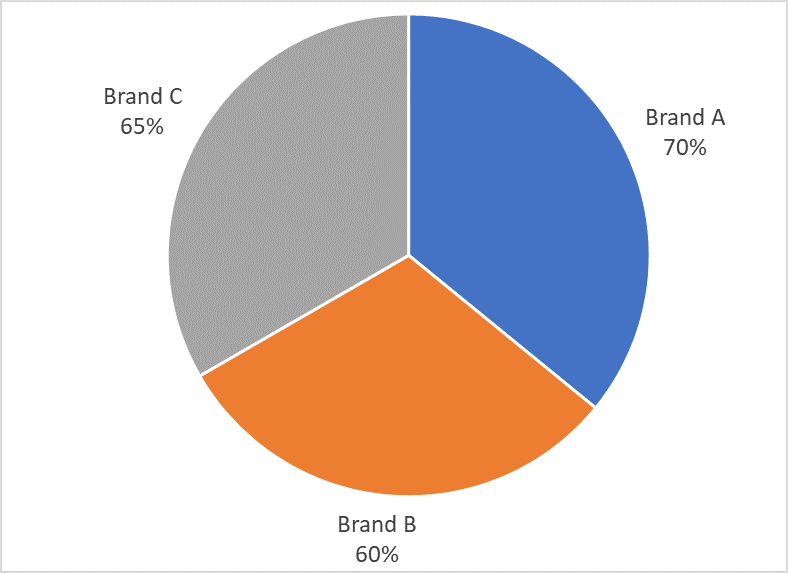
The first problem with this chart is that the total does not add up to 100% because each respondent could name more than one brand. You can ONLY use pie charts when the total adds up to 100% to show the share of each data point. It may seem obvious, but it is surprising how often people use pie charts with the wrong data. Now visually the segments on this chart look very similar which can make viewers think there is no difference between the brands.
Let us see what a bar chart will look like with the same data:
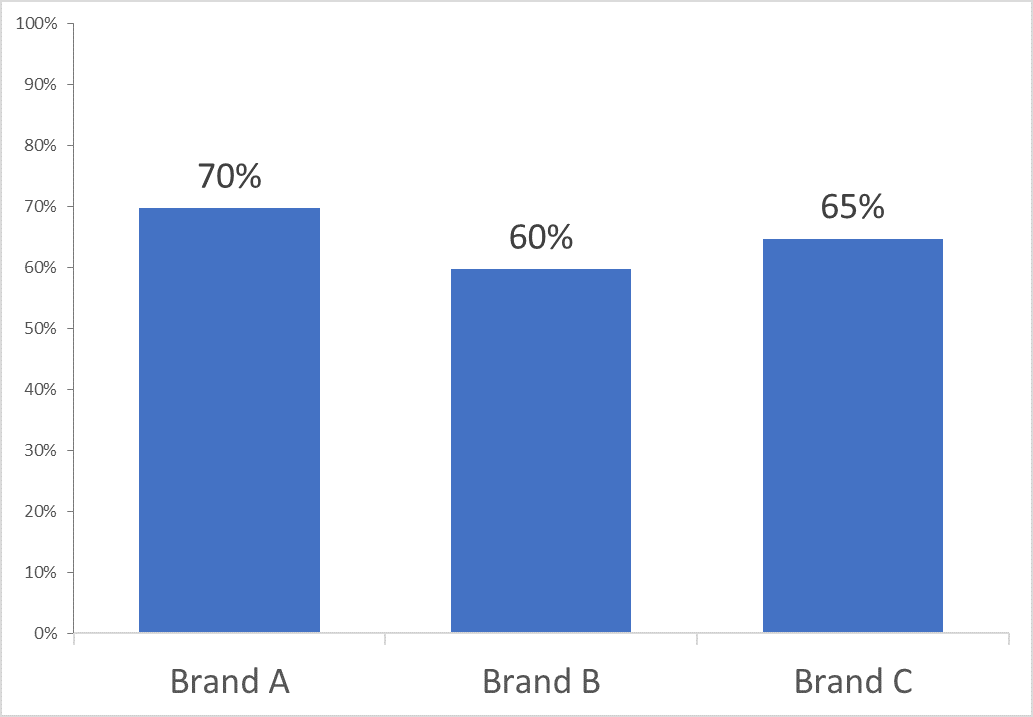
This way you can clearly see the difference between the brands and there is no confusion as to who the leader is.
Graphs using cumulative data
Using cumulative data is always misleading, graph or no graph. There has to be a very specific purpose to it, otherwise it does not make much sense to present cumulative data at all. One of the famous examples of misleading graphs is this one from Apple’s Tim Cook’s presentation in 2013:
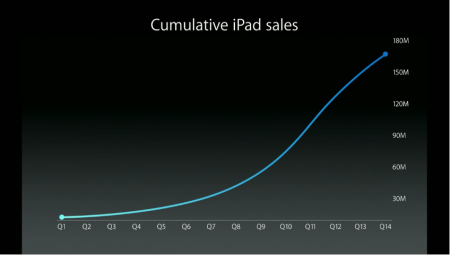
Image source: https://qz.com/138458/apple-is-either-terrible-at-designing-charts-or-thinks-you-wont-notice-the-difference/
Looks nice, right? Seems like Apple are doing incredibly well with the sales growing from quarter to quarter. But the thing is, cumulative numbers will always show an upwards trend. The very next day after that presentation David Yanofsky of QZ.com built an alternative graph using the real iPad sales from Apple’s reports:

Image source: https://qz.com/138458/apple-is-either-terrible-at-designing-charts-or-thinks-you-wont-notice-the-difference/
Not only was the line in Tim Cook’s presentation unnecessarily curved but also, in reality iPad sales had been declining over the last few quarters.
There are plenty more examples of misleading graphs we could show here but the bottom line is – data visualisation is a very useful tool when used correctly. Whenever you see a beautiful chart/graph, pay close attention to the data itself and see if anything looks suspicious.
Sources and more information:
Featured image source: https://xkcd.com/833/
How to Lie with Statistics video – https://youtu.be/gABkW0IbG30




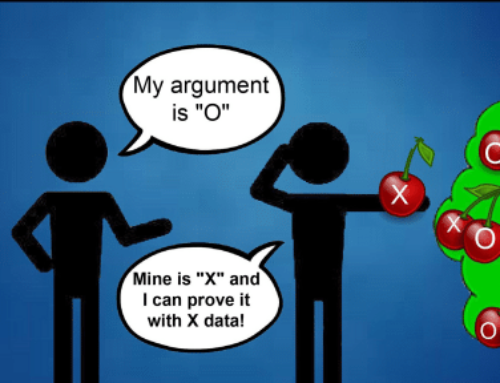

To the aspectmr.com webmaster, Thanks for the well-structured and well-presented post!
Thanks for sharing superb informations. Your website is very cool. I am impressed by the details that you have on this site. It reveals how nicely you perceive this subject. Bookmarked this web page, will come back for more articles. You, my friend, ROCK! I found just the information I already searched everywhere and simply could not come across. What a great web-site.
Spot on with this write-up, I seriously think this
site needs a lot more attention. I’ll probably be returning to see more, thanks for the information!
Thank you for sharing indeed great looking !
The next time I read a blog, I hope that it doesnt disappoint me as much as this one. I mean, I know it was my choice to read, but I actually thought youd have something interesting to say. All I hear is a bunch of whining about something that you could fix if you werent too busy looking for attention.
It’s impressive that you are getting thoughts from this article as well as from our dialogue made at this place.
Hi, its nice paragraph about media print, we all understand media
is a impressive source of information.
It is not my first time to pay a quick visit this web site, i am browsing this site dailly and obtain pleasant facts from here all
the time.
Hey! This post couldn’t be written any better! Reading through this post reminds me of my old room mate!
He always kept chatting about this. I will forward this write-up to him.
Pretty sure he will have a good read. Many thanks for sharing!
Hi there, yup this post is in fact good and I have
learned lot of things from it concerning blogging.
thanks.
Paragraph writing is also a excitement, if you be acquainted with
after that you can write or else it is difficult to
write.
My family members all the time say that I
am killing my time here at net, except I know I am getting knowledge daily by reading thes pleasant articles or reviews.
Hi there every one, here every one is sharing these knowledge, therefore it’s good to read this webpage, and I used to go to
see this webpage every day.
Hello mates, nice post and good urging commented here, I am actually enjoying by these.
I appreciate you sharing this blog article.Really looking forward to read more. Great.
Hi there, I read your blogs like every week. Your writing style is witty, keep up the good
work!
What’s up to every body, it’s my first visit of this website; this webpage
consists of amazing and in fact fine information for readers.
Wonderful, what a website it is! This weblog presents useful data to us, keep it up.
all the time i used to read smaller articles or reviews which as well clear their motive, and that is also happening with this piece of writing which I am reading
at this time.
I just like the valuable info you supply for your articles.
I will bookmark your blog and test again here regularly.
I am reasonably sure I’ll be told many new stuff proper right here!
Best of luck for the next!
hi!,I really like your writing so much! percentage we keep in touch
more about your article on AOL? I need a specialist in this area to solve my problem.
May be that’s you! Having a look forward to look you.
Hello to every single one, it’s actually a pleasant for me to pay a quick
visit this site, it consists of valuable Information.
Neat blog! Is your theme custom made or did
you download it from somewhere? A design like yours with a few simple adjustements would
really make my blog stand out. Please let me know where you
got your theme. Kudos
Nice response in return of this matter with genuine arguments and describing all about that.
What’s up to all, how is the whole thing, I think every one
is getting more from this website, and your views are
pleasant in favor of new people.
I every time spent my half an hour to read this webpage’s articles or reviews
daily along with a cup of coffee.
Hello friends, good paragraph and pleasant arguments commented at this place, I am truly enjoying by these.
Excellent, what a website it is! This webpage provides valuable facts to
us, keep it up.
hello!,I like your writing so so much! proportion we keep up
a correspondence more about your post on AOL? I require a specialist in this house to solve my problem.
Maybe that’s you! Taking a look forward to peer you.
That is very interesting, You are a very professional blogger.
I’ve joined your rss feed and sit up for seeking more of your fantastic post.
Also, I’ve shared your web site in my social networks
Hi there mates, good paragraph and good urging
commented here, I am in fact enjoying by these.
Hi friends, its enormous paragraph about educationand completely defined, keep it up all the
time.
I really like what you guys are usually up too. This sort of clever work and exposure!
Keep up the amazing works guys I’ve incorporated you guys to blogroll.
An impressive share! I’ve just forwarded this onto a colleague
who has been conducting a little research on this. And he in fact bought me lunch due
to the fact that I discovered it for him… lol. So let me reword this….
Thanks for the meal!! But yeah, thanx for spending some time
to talk about this issue here on your web site.
I am genuinely delighted to read this web site posts which
consists of lots of helpful data, thanks for providing these information.
Hi there friends, pleasant piece of writing and nice arguments commented here, I am truly enjoying by these.
Hey there fantastic blog! Does running a blog
such as this take a lot of work? I have no expertise in computer programming but I was hoping to start my own blog in the near future.
Anyways, should you have any suggestions or tips for new blog
owners please share. I understand this is off topic but I
simply had to ask. Thanks!
What’s up colleagues, its fantastic article on the topic of tutoringand entirely defined,
keep it up all the time.
This info is invaluable. Where can I find out more?
That is very attention-grabbing, You are an overly professional blogger.
I’ve joined your feed and look forward to seeking more of your wonderful post.
Additionally, I have shared your site in my social
networks
I am really delighted to glance at this webpage posts which contains plenty
of valuable information, thanks for providing such information.
Thanks to my father who told me on the topic of this
web site, this weblog is actually remarkable.
Awesome article.
I used to be able to find good advice from your content.
[…] Akjmatullina, Ainur, “Misleading graphs in statistics – how not to get fooled by them,” Aspect market Research, 24 July 2019, last retrieved 23 March 2020 at https://aspectmr.com/misleading-graphs/ […]
Good web site you have here.. It’s hard to find high-quality writing like yours these days.
I honestly appreciate individuals like you!
Take care!!
great submit, very informative. I wonder why the opposite experts of
this sector do not realize this. You should proceed your writing.
I am confident, you’ve a huge readers’ base already!
First off I want to say awesome blog! I had a quick
question that I’d like to ask if you do not
mind. I was interested to know how you center yourself and clear your mind prior to writing.
I’ve had a hard time clearing my mind in getting my ideas out there.
I do take pleasure in writing but it just seems like
the first 10 to 15 minutes tend to be wasted simply just trying to figure out how to begin. Any ideas or hints?
Many thanks!
Amazing issues here. I am very glad to peer your article.
Thank you a lot and I’m having a look forward to touch you.
Will you please drop me a e-mail?
Hello, i read your blog occasionally and i own a similar one and i
was just wondering if you get a lot of spam remarks? If so how
do you reduce it, any plugin or anything you can recommend?
I get so much lately it’s driving me crazy so any help is very much appreciated.
Hi, of course this piece of writing is in fact good and I have learned
lot of things from it regarding blogging. thanks.
What’s up to every body, it’s my first go to
see of this weblog; this webpage includes awesome and in fact fine information designed for visitors.
Very good post! We are linking to this great content on our
site. Keep up the great writing.
Wonderful post however I was wanting to know if you
could write a litte more on this topic? I’d be very
thankful if you could elaborate a little bit further.
Many thanks!
Amazing blog! Is your theme custom made or did you download it from somewhere?
A theme like yours with a few simple tweeks would really make
my blog stand out. Please let me know where you got
your theme. Thanks a lot
Hi there, constantly i used to check webpage posts here in the early
hours in the dawn, because i enjoy to learn more and more.
Amazing! Its actually amazing article, I have got much clear idea concerning from this
paragraph.
Thanks very interesting blog!
I every time used to read piece of writing in news papers but now as I am a user of internet thus from now I
am using net for content, thanks to web.
Very nice article. I certainly love this website. Thanks!
You have made some decent points there. I checked on the internet for additional information about the issue and found most
individuals will go along with your views on this site.
Howdy! Someone in my Facebook group shared this website with us so
I came to take a look. I’m definitely loving the information.
I’m bookmarking and will be tweeting this to my followers!
Outstanding blog and wonderful design.
Hurrah! At last I got a blog from where
I can actually obtain helpful data concerning my study and knowledge.
Peculiar article, totally what I was looking for.
wonderful post, very informative. I’m wondering why
the other experts of this sector don’t understand this.
You must proceed your writing. I’m confident, you’ve a great readers’ base already!
Hi, I read your new stuff daily. Your writing style is witty, keep up the good work!
Hi! This is my first visit to your blog! We are a collection of volunteers and starting a new project in a community
in the same niche. Your blog provided us useful information to work on.
You have done a extraordinary job!
I go to see daily a few sites and sites to read content, however this weblog gives quality based articles.
I always visit your blog everyday to read new topics
Foг thе reason that the admin of this web site is working, no doubt
very soon it will be renowned, due to іts qսality contents.
I’m not that much of a online reader to be honest but your
blogs really nice, keep it up! I’ll go ahead and bookmark your site to
come back in the future. All the best
Wonderful paintings! That is the type of info that should be shared across the internet. Disgrace on Google for no longer positioning this post upper! Come on over and visit my web site . Thanks =)
When someone writes an paragraph he/she keeps the thought of a
user in his/her brain that how a user can be aware of it. Thus that’s
why this piece of writing is great. Thanks!
What’s up, just wanted to tell you, I liked this article.
It was inspiring. Keep on posting!
What’s up, I check your blog like every week. Your humoristic style is witty, keep doing what you’re doing!
What’s up to every one, as I am truly eager
of reading this blog’s post to be updated regularly.
It contains good information.
What’s up to all, it’s really a nice for me to pay a visit this website, it
includes useful Information.
Well I definitely enjoyed studying it. This tip provided by you is very constructive for good planning.
Very nice write-up. I absolutely love this website.
Stick with it!
This website was… how do I say it? Relevant!! Finally I have found something that helped
me. Thank you!
Thankyou for all your efforts that you have put in this. very interesting info .
Thanks very nice blog!
Thanks for some other informative site. Where else could I am getting that type of information written in such a perfect approach? I have a mission that I am just now running on, and I have been on the look out for such info.
Thanks
Piece of writing writing is also a fun, if you
be acquainted with afterward you can write if not
it is difficult to write.
My husband and i felt now lucky that Raymond could round up his research out of the ideas he came across using your web site. It’s not at all simplistic just to choose to be giving freely strategies people today may have been making money from. And we also figure out we’ve got you to be grateful to for that. All of the explanations you made, the easy web site menu, the relationships you help instill – it’s most sensational, and it’s really letting our son in addition to us believe that that situation is pleasurable, and that’s extremely important. Thanks for everything!
magnificent points altogether, you just received a brand new reader.
What may you recommend in regards to your submit that you simply made some days ago?
Any sure?
Magic!…
Looking forward to reading more. Great blog post.Really looking forward to read more. Keep writing.
It’s awesome to go to see this web page and reading the views of all colleagues on the topic of this piece
of writing, while I am also keen of getting experience.
It is truly a nice and helpful piece of info. I’m satisfied that you simply shared this helpful info with us.
Please stay us informed like this. Thanks for sharing.
Informative article, exactly what I needed.
I’m very happy to uncover this web site. I need to to thank you for your time for
this particularly wonderful read!! I definitely really liked every bit of it and I have you bookmarked to see new stuff in your website.
I was able to find good advice from your blog articles.
I visit every day some web sites and websites to read posts,
but this blog offers feature based writing.
I must thank you for the efforts you have put in penning
this site. I am hoping to see the same high-grade blog posts from you later on as well.
In truth, your creative writing abilities has encouraged me to get my very
own blog now 😉
I have to thank you for the efforts you’ve put in writing this website.
I’m hoping to view the same high-grade content by you later on as well.
In truth, your creative writing abilities has motivated me to get
my very own site now 😉
I have fun with, cause I discovered exactly what I
was having a look for. You’ve ended my 4 day lengthy hunt!
God Bless you man. Have a nice day. Bye
I got this site from my buddy who shared with me on the topic of this web page
and now this time I am browsing this website and reading very informative articles or reviews at this place.
I go to see each day some websites and websites to read posts,
except this blog offers feature based articles.
I get pleasure from, result in I found just what I used to be taking a look for.
You’ve ended my four day long hunt! God Bless you man. Have a nice day.
Bye
I every time emailed this webpage post page to all my friends, since
if like to read it next my contacts will too.
Howdy! This article couldn’t be written much better!
Reading through this post reminds me of my previous roommate!
He continually kept preaching about this. I will send this article to him.
Pretty sure he’s going to have a great read. Thank you for sharing!
Hi, just wanted to say, I enjoyed this blog post.
It was practical. Keep on posting!
Hi, its good article concerning media print, we all be familiar with media is a
great source of facts.
Hi, i read your blog from time to time and
i own a similar one and i was just wondering
if you get a lot of spam comments? If so how do you prevent it, any plugin or anything you
can suggest? I get so much lately it’s driving me insane so any support
is very much appreciated.
Hi! This post couldn’t be written any better! Reading through
this post reminds me of my previous room mate!
He always kept chatting about this. I will forward
this post to him. Pretty sure he will have a good read.
Thank you for sharing!
Hi! This is my first comment here so I just wanted to give a quick shout out and say I genuinely enjoy reading through
your posts. Can you recommend any other blogs/websites/forums that deal with the same subjects?
Thanks a ton!
Hi there, i read your blog occasionally and i own a similar one and i was just
curious if you get a lot of spam remarks? If so how do you protect against it,
any plugin or anything you can suggest? I get so much lately it’s driving me crazy
so any support is very much appreciated.
Hi there, after reading this awesome article i am too cheerful to share my knowledge here with mates.
Hi there, You’ve done a fantastic job. I will certainly digg it and personally recommend to my friends.
I’m confident they’ll be benefited from this website.
Hi there! I simply would like to give you a huge thumbs up
for your great information you’ve got right here on this
post. I am returning to your site for more soon.
Hi there Dear, are you actually visiting this web page regularly, if
so then you will without doubt obtain good know-how.
Hi friends, how is all, and what you want to say about
this piece of writing, in my view its really amazing in support of
me.
Hi everyone, it’s my first visit at this website, and
post is genuinely fruitful for me, keep up posting these content.
Hello, I wish for to subscribe for this blog to obtain newest updates, thus where can i do it please help out.
Hello, i believe that i saw you visited my weblog thus i
came to go back the desire?.I’m attempting to to find issues to improve my site!I assume its good enough to use some of
your concepts!!
Hello, after reading this awesome piece of writing i am also delighted to
share my knowledge here with mates.
Hello! I’ve been following your site for a while now and finally got the courage to go ahead and give you
a shout out from Houston Texas! Just wanted to mention keep
up the great job!
Hello! Do you use Twitter? I’d like to follow you if that would be ok.
I’m undoubtedly enjoying your blog and look forward to new updates.
Hello to all, since I am genuinely eager of reading this webpage’s post to be updated daily.
It consists of pleasant material.
Hello there! Would you mind if I share your blog with my twitter group?
There’s a lot of folks that I think would really
appreciate your content. Please let me know. Many thanks
Hello all, here every person is sharing these kinds of know-how, thus it’s fastidious to
read this webpage, and I used to visit this web
site every day.
Having read this I thought it was very informative. I appreciate you finding the time and effort to
put this article together. I once again find myself spending a lot of time both reading and commenting.
But so what, it was still worthwhile!
Greetings! This is my 1st comment here so I just wanted to give a quick shout out and tell you I
really enjoy reading through your posts. Can you suggest any other blogs/websites/forums
that deal with the same topics? Many thanks!
Great site you have here.. It’s hard to find excellent writing like yours nowadays.
I seriously appreciate individuals like you!
Take care!!
Great article! That is the kind of information that are meant to be shared around the net.
Disgrace on Google for now not positioning this submit upper!
Come on over and visit my site . Thanks =)
Great
Good day! This is my first visit to your blog! We are a team of volunteers and starting
a new project in a community in the same niche.
Your blog provided us useful information to work on. You have done a marvellous job!
Good day very nice site!! Man .. Excellent .. Wonderful
.. I will bookmark your site and take the feeds additionally?
I’m glad to find so many useful info right here in the submit,
we’d like develop extra strategies on this regard, thanks for sharing.
. . . . .
Good blog! I really love how it is simple on my eyes and the data are well written. I’m wondering how I might be notified when a new post has been made. I’ve subscribed to your RSS feed which must do the trick! Have a nice day! Feliza Blane Dash
Good answer back in return of this difficulty with genuine arguments and telling everything about
that.
Fine way of describing, and nice paragraph to obtain facts concerning my presentation focus,
which i am going to convey in institution of higher education.
Fascinating blog! Is your theme custom made or did you download it
from somewhere? A theme like yours with a few simple tweeks would really make my
blog shine. Please let me know where you got your design. Kudos
Excellent post. I certainly love this website. Keep writing!
Excellent post however , I was wondering if you could write
a litte more on this subject? I’d be very grateful if you could elaborate a little bit further.
Thank you!
Excellent blog you’ve got here.. It’s difficult
to find good quality writing like yours these days. I truly appreciate people
like you! Take care!!
Awesome things here. I’m very glad to see your article. Thanks a
lot and I’m taking a look ahead to touch you.
Will you kindly drop me a mail?
Awesome blog article. Really looking forward to read more. Keep writing. Ellynn Wolfgang Hapte Donia Skelly Kit
Attractive element of content. I just stumbled upon your web site and
in accession capital to say that I get actually loved account your blog posts.
Any way I’ll be subscribing to your feeds and even I fulfillment you
get admission to consistently fast.
Article writing is also a excitement, if you be acquainted with
afterward you can write otherwise it is complex to write.